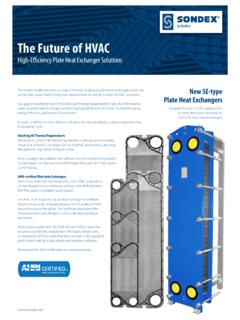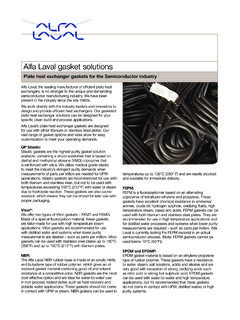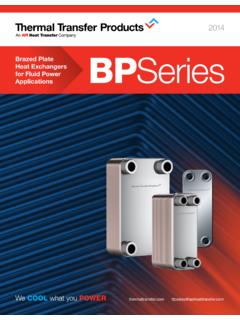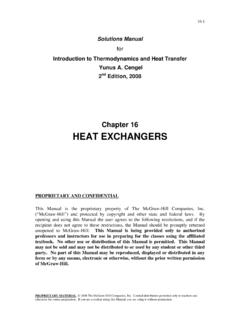Transcription of Stefan Tranter AB, Sweden,
1 Stefan Gavelin, Tranter International AB, Sweden, explains the advantages of using shell and plate heat exchangers over other designs. Shell and plate , worth the wait P. late heat exchangers have been used for many years in the hydrocarbon industry. The advantages of plate heat exchangers became more apparent with the introduction of the gasket free all welded plate heat exchangers in the early 1990s. However, the traditional all welded heat exchangers with square/rectangular plates (the four corner grid design) suffer from thermal and pressure fatigue due to the weak corner welds that often fail in dynamic processes, which results in unexpected shutdown and maintenance.
2 Therefore, this design should be replaced by more reliable shell and plate heat exchangers in order to improve reliability and availability. The benefits of using plate heat exchangers are well known. They are more efficient, occupy less space, are lighter and do not need to be cleaned as often as shell and tube heat exchangers. When the material is exotic (high cost), the cost is less than for traditional shell and tube heat exchangers due to lower heat transfer area requirements; therefore, costs are reduced where corrosive fluids are present.
3 The traditional welded plate heat exchangers available are of the four corner grid design and are manufactured Reprinted from September2009 HydrocarbonEngineering from either rectangular or square plates. These plates have rectangular/square plates are only suitable for continuous sharp corner welds that, from a fatigue point of view, are processes with minor fluctuations in temperature and catastrophic and insidious as the welds can fail without pressure. In the unlikely event that a process is 100%. warning. continuous over a longer period of time, this type of welded exchanger is well suited for the process.
4 However, if 100%. Shell and plate design stability cannot be guaranteed by the process licensor nor The shell and plate heat exchanger is a highly efficient, the operator, this type of heat exchanger should not be used. reliable compact plate heat exchanger . Despite the excellent When a weld fails, it must be repaired immediately and this performance in both stable and dynamic processes, will cause unexpected downtime, which can be very costly. many engineers are questioning the performance due Repairing the failed weld is not always a simple task and a to lack of product knowledge and operating experience.
5 Weld repair is only viable for special cases. Many engineers are reluctant to try them without a great The design of any component can have a significant deal of support in terms of process references and actual influence on its fatigue characteristics. Any geometrical recommendations from process licensors. plate technology discontinuity can act as a stress raiser and fatigue crack has been used successfully for more than a decade in main initiation position. The sharper the discontinuity ( the hydrocarbon processes. smaller the radius of curvature), the more dangerous the The shell and plate heat exchanger has presented stress concentration.
6 The probability of fatigue failure can solutions to some of the traditional shell and tube/four be reduced by avoiding such structural irregularities and by corners grid limitations. It provides the thermal efficiency and making a design where sudden contour changes leading to the compactness of a plate heat exchanger while handling sharp corners are eliminated. This is exactly what the shell pressures and temperatures otherwise requiring shell and and plate design provides and in addition to excellent thermal tube units. Its excellent resistance to thermal and pressure fatigue resistance, it also has the same thermal performance fatigue makes it superior to other welded technologies.
7 As all other welded heat exchangers on the market. The shell and plate design can also withstand challenging Recently, for welded plate heat exchangers, pressure process conditions with liquids, gases, steam and two phase fatigue (isothermal) has been shown not to be as critical an mixtures. The compact design enables very close temperature issue as thermal mechanical fatigue; initial tests of a welded approaches and the small holdup volume provides fast plate pack consisting of circular plates ran into tens of startups and close following of process changes.
8 Thousands of cycles with relatively high frequency pressure fluctuations. The standard thermal fatigue test also exposes Fatigue resistance/testing the heat exchanger to 5 - 10 bar pressure fluctuations Fatigue failure occurs in components exposed to dynamic and and differentials (same side fluctuations, opposite side fluctuating stresses. Under such circumstances, it is possible differentials). Specific information about the exact number of for failure to occur at a stress level considerably lower than the cycles a shell and plate can withstand is proprietary.
9 However, tensile or yield strength for a static load. Fatigue is important most of them can withstand temperature fluctuations of over because it is the single largest cause of failure in metals, 150 C for several thousand cycles. estimated to comprise approximately 90% of all failures. The The procedure for measuring the thermal fatigue maximum stress on a welded plate heat exchanger occurs at resistance is not per any recognised standard. Common the circumferential welds around the port holes and the outer standards ( ASTM) not only define the test method, but diameter of the plates.
10 The cracks leading to failure originate at stress amplification places and it is therefore not hard to understand why circular plates have better fatigue resistance than rectangular plates. If thermal fatigue resistance is an important design parameter, it is easy to understand that the traditional FIgure 1. Schematic of a circular and a rectangular (four corner grid) plate . As shown, the circular Figure 2. A welded plate pack plate completely avoids the critical for a shell and plate heat exchanger . The automatic corner welds. welding process provides excellent high quality welds.









